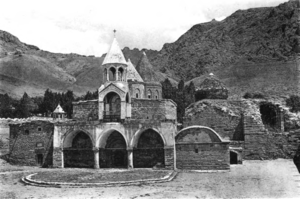Varagavank
| Varagavank | |
|---|---|

The monastery c. 1913
|
|
| Basic information | |
| Location | Yukarı Bakraçlı,Van Province, Turkey |
| Geographic coordinates | 38°26′59″N 43°27′39″E / 38.449636°N 43.460825°ECoordinates: 38°26′59″N 43°27′39″E / 38.449636°N 43.460825°E |
| Affiliation | Armenian Apostolic Church |
| Status | several buildings destroyed, continuous deterioration of others |
| Architectural description | |
| Architectural style | Armenian |
| Founder | Senekerim-Hovhannes |
| Groundbreaking | early 11th century |
Varagavank (Armenian: Վարագավանք, "Monastery of Varag";Turkish: Yedi Kilise, "Seven Churches") was an Armenian monastery on the slopes of Mount Varag (Erek Dağı), 9 km (5.6 mi) southeast of the city of Van, in eastern Turkey.
The monastery was founded in the early 11th century by Senekerim-Hovhannes, the Armenian King of Vaspurakan, on a preexisting religious site. Initially serving as the necropolis of the Artsruni kings, it eventually became the seat of the archbishop of the Armenian Church in Van. The monastery has been described as one of the great monastic centers of the Armenian church by Ara Sarafian and the richest and most celebrated monastery of the Lake Van area by Robert H. Hewsen.
During the Armenian Genocide, in April–May 1915, the Turkish army attacked, burned, and destroyed much of the monastery. Much of it was destroyed in the 1960s, although good sections are barely extant.
According to tradition, in the late 3rd century, St. Rhipsime hid the remnant of the True Cross she wore on her neck at the site of the monastery. In 653, when the location was discovered, Catholicos Nerses III the Builder built the Church of Surb Nshan (Holy Seal). It is described by Robert H. Hewsen as "a simple hermitage". Catholicos Nerses also established the Feast of the Holy Cross of Varag (Վարագա սուրբ խաչի տոն), celebrated by the Armenian Apostolic Church on the Sunday nearest to September 28, always two weeks after the Feast of the Exaltation of the Cross.
...
Wikipedia

